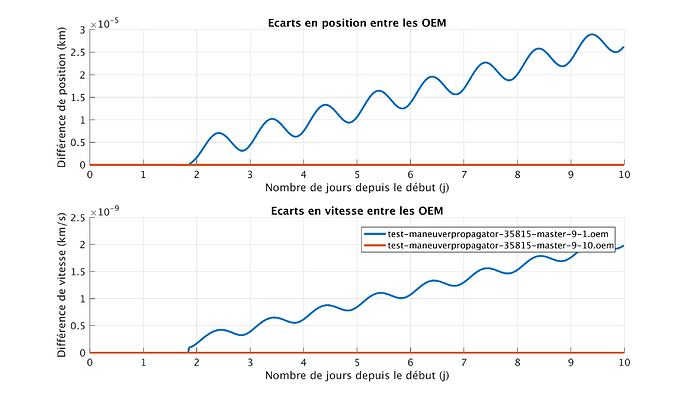I ran your code. I didn’t observe the problem of modification of the orbit.
But I have a question: the date of the maneuver is the same as the date for the end of the propagation. So, you do not propagate after the maneuver: that’s what you want to do?
Orbite initiale :
Date de debut : 2018-08-31T00:00:00.000
Cartesian parameters: {2018-08-31T00:00:00.000, P(3.77279251691374E7, 1.8861471230199E7, -26502.8594459892), V(-1372.8424195657, 2750.00801092554, 0.04512254183365766), A(-0.20039231735928986, -0.10018292582166853, 1.4077024901899075E-4)}
Orbite avant manoeuvre :
Date de la manoeuvre : 2018-09-10T00:00:00.000
Cartesian parameters: {2018-09-10T00:00:00.000, P(3.39637460890208E7, 2.5014699658136625E7, -43029.03891703195), V(-1821.222271099359, 2475.7268093313883, 0.6779890964996327), A(-0.18037992560927552, -0.13286191386885463, 2.2722305049791065E-4)}
dV : {-0; 0; 0}
Orbite après manoeuvre :
Date de la manoeuvre : 2018-09-10T00:00:00.000
Cartesian parameters: {2018-09-10T00:00:00.000, P(3.39637460890208E7, 2.5014699658136625E7, -43029.03891703195), V(-1821.222271099359, 2475.7268093313883, 0.6779890964996327), A(-0.1803804399785667, -0.1328523219564699, 2.285259391400916E-4)}
Orbite finale :
Date de fin : 2018-09-10T00:00:00.000
Cartesian parameters: {2018-09-10T00:00:00.000, P(3.39637460890208E7, 2.5014699658136625E7, -43029.03891703195), V(-1821.222271099359, 2475.7268093313883, 0.6779890964996327), A(-0.1803804399785667, -0.1328523219564699, 2.285259391400916E-4)}
With another date for the maneuver (1 day before) and a deltaV of 0m/s :
Orbite initiale :
Date de debut : 2018-08-31T00:00:00.000
Cartesian parameters: {2018-08-31T00:00:00.000, P(3.77279251691374E7, 1.8861471230199E7, -26502.8594459892), V(-1372.8424195657, 2750.00801092554, 0.04512254183365766), A(-0.20039231735928986, -0.10018292582166853, 1.4077024901899075E-4)}
Orbite avant manoeuvre :
Date de la manoeuvre : 2018-09-09T00:00:00.000
Cartesian parameters: {2018-09-09T00:00:00.000, P(3.438932101021747E7, 2.442717536324472E7, -41980.147241723505), V(-1778.3170966640075, 2506.663228015379, 0.6940894145664359), A(-0.18263615645183995, -0.12973846422836352, 2.2127683011649964E-4)}
dV : {-0; 0; 0}
Orbite après manoeuvre :
Date de la manoeuvre : 2018-09-09T00:00:00.000
Cartesian parameters: {2018-09-09T00:00:00.000, P(3.438932101021747E7, 2.442717536324472E7, -41980.147241723505), V(-1778.3170966640075, 2506.663228015379, 0.6940894145664359), A(-0.1826343492059699, -0.12972751843750605, 2.2294760832250815E-4)}
Orbite finale :
Date de fin : 2018-09-10T00:00:00.000
Cartesian parameters: {2018-09-10T00:00:00.000, P(3.396374608907751E7, 2.5014699658131048E7, -43029.03892086521), V(-1821.2222710931653, 2475.7268093321964, 0.6779890962555428), A(-0.18037992560903324, -0.13286191386842472, 2.27223050517581E-4)}
With a deltaV of 1m/s:
Orbite initiale :
Date de debut : 2018-08-31T00:00:00.000
Cartesian parameters: {2018-08-31T00:00:00.000, P(3.77279251691374E7, 1.8861471230199E7, -26502.8594459892), V(-1372.8424195657, 2750.00801092554, 0.04512254183365766), A(-0.20039231735928986, -0.10018292582166853, 1.4077024901899075E-4)}
Orbite avant manoeuvre :
Date de la manoeuvre : 2018-09-09T00:00:00.000
Cartesian parameters: {2018-09-09T00:00:00.000, P(3.438932101021747E7, 2.442717536324472E7, -41980.147241723505), V(-1778.3170966640075, 2506.663228015379, 0.6940894145664359), A(-0.18263615645183995, -0.12973846422836352, 2.2127683011649964E-4)}
dV : {-0,5786160259; 0,8156000513; 0,0002258378}
Orbite après manoeuvre :
Date de la manoeuvre : 2018-09-09T00:00:00.000
Cartesian parameters: {2018-09-09T00:00:00.000, P(3.438932101021747E7, 2.442717536324472E7, -41980.147241723505), V(-1778.895712689876, 2507.478828066633, 0.694315252387715), A(-0.1826343492059699, -0.12972751843750605, 2.2294760832250815E-4)}
Orbite finale :
Date de fin : 2018-09-10T00:00:00.000
Cartesian parameters: {2018-09-10T00:00:00.000, P(3.411623024064095E7, 2.4806046645751208E7, -43087.63729792053), V(-1806.5917041274254, 2487.675070421675, 0.6589003484971477), A(-0.18119191106486746, -0.13175527530648762, 2.275305337229292E-4)}
One remark: for the computation of the deltaV, you could code it:
Vector3D dVVector = vitesse.normalize().scalarMultiply(dVValue);
instead of
Vector3D dVVector = new Vector3D(dVValue * vitesse.getX() / vitesse.getNorm(),
dVValue * vitesse.getY() / vitesse.getNorm(),
dVValue * vitesse.getZ() / vitesse.getNorm());
Christophe
![]()
![]()
